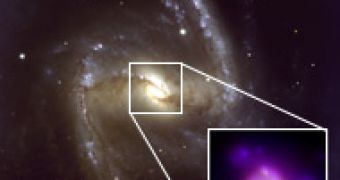There appears to be a link between the way in which galaxies form and take their shape and the supermassive black holes at their center. There?s a correlation between the speed of dispersion of the spheroidal cloud of original gas, and the mass of the massive black hole. Scientists detected enormous 'tornadoes' powered by tidal 'winds' created by powerful gravitational forces originating from the black hole.
These new discoveries may shed new light on the evolution of galaxies and the early universe. Supermassive black holes usually occur in the center of galaxies, where the density of matter is higher. Since the largest ever discovered black hole had the mass of about 24 times that of the Sun, it is generally considered that supermassive black holes can not form is any other places, due to the lack of material to accrete.
The research was mainly focused on the galaxy PG 1700+158, located at a distance of about 3 billion light years away from our Milky Way. Black holes pull enormous gas clouds into their orbit to form an accretion disk. Due to high velocities at which the accretion disk is spinning, the cloud of gas heats up to temperatures that can outshine a hole galaxy, emitting light in most of the electromagnetic spectrum, especial in the visible, ultraviolet and infrared.
By breaking down the light into the colors that make it, scientists where able to observe subtle shifts in its wavelengths, effect interpreted as a cyclonic wind moving above the black hole, at speeds as close as 4000 kilometers per second, more intense than any storm ever recorded on Earth, or elsewhere in the universe.
Such powerful winds have the capability to shape an entire galaxy, and cause effects that reach well beyond its borders, such as heating the surrounding vacuum around the galaxy which will prevent the condensation of matter and the formation of new galaxies; such an effect might have had a important role in restricting the size of the forming galaxies.
So far, the observations need to be correlated, and confirmed by further information. Observation was made using the William Herschel Telescope situated in the Canary Islands, working in the optical/infrared domain.

 14 DAY TRIAL //
14 DAY TRIAL //